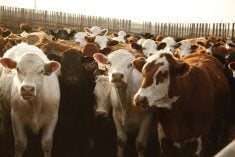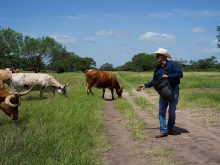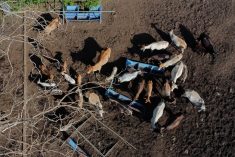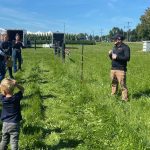In calves, to control:
Cattle producers may think vaccination prevents disease and that’s accurate only to a point.
Dr. Nathan Erickson, a veterinarian and instructor at the Western College of Veterinary Medicine in Saskatoon, prefers to think of it as control of an illness rather than complete prevention.
“Prevention creates in our mind the idea that we’re going to stop something bad from happening … and I think that creates a little bit of a misconception and perhaps improper expectation,” Erickson said during a January webinar organized by the Beef Cattle Research Council.
Read Also

Agri-business and farms front and centre for Alberta’s Open Farm Days
Open Farm Days continues to enjoy success in its 14th year running, as Alberta farms and agri-businesses were showcased to increase awareness on how food gets to the dinner plate.
“But (vaccination) will reduce a lot of the disease. It will control. It will restrain…. Also it will reduce the incidence or the severity.”
Those advantages resonate with most cow-calf producers. More than 91 percent of ranchers surveyed in the 2014-15 Western Canada cow-calf survey said they vaccinate.
Erickson listed the goals he sets for a vaccination protocol:
- Reduce the number of animals shedding pathogens.
- Decrease quantity of pathogen shed.
- Reduce length of shedding period.
- Increase the amount of pathogen needed to cause new cases.
One sick animal can have major effects on a herd that hasn’t been vaccinated for that illness, said Erickson.
Other stories in this special feature on animal health:
- Benefits of early vaccinations carry on through calf’s life: research
- Pain management important but not straightforward
- Pain relief both ethical and economical
- Nasal vaccines deliver solid infection protection
- Low-cost producers must vaccinate animals
For example, if two animals are shedding a virus, each is likely to infect at least seven other animals. If the herd is vaccinated and two animals are sick, they are likely to infect only two other animals each.
“What we’ve done is, we’ve reduced the amount of shedding. We’ve reduced the shedding period,” he said.
Vaccination is only part of a disease control program, however, and its effectiveness depends on the disease being managed and on factors such as the animals’ nutrition, environment and new animal introductions to the herd.
Efficacy of vaccination may also be reduced by inappropriate timing, improper vaccine handling, technique, equipment, structure of the pathogen involved or even vaccinating for the wrong illness.
Erickson said vaccine should not be stored in the door of the fridge because that area has inconsistent temperature. Instead, it should be stored in the middle shelf at the back of the fridge.
This is especially important for modified live vaccines, which are sensitive to temperature change.
When using the latter type, mix only what will be used within the next hour. Once mixed, avoid direct heat and freezing, as well as prolonged exposure to light, advised Erickson.
Syringe maintenance is often overlooked, he added, but is key to good vaccine delivery.
Syringes should be washed with warm water, not with soap or disinfectants. When cleaning, take the syringe apart, wash off debris and wait until the parts are dry before putting it back together.
Use a vegetable oil on the rubber ring to keep it supple and effective.
Erickson advised producers to check their syringes periodically to ensure they are administering the dose indicated.
“They do wear out over time,” he said.
When vaccinating, the needle on the syringe should be changed every time it is refilled, or alternatively, changed after every 10 animals.
The needle should also be changed when starting a new bottle of vaccine. Otherwise, producers risk contamination of a new batch.
Erickson also offered advice when treating animals that are already sick.
“Sometimes we try to vaccinate our way out of an outbreak,” he said.
That can work, but it requires patience. It might take four weeks for a sick animal to respond if it’s the first dose of vaccine because the animal’s immune system is already activated. Even a booster may require two weeks to illicit a response.
Erickson said an intranasal vaccine might be an option on an animal already sick because it can stimulate an immediate response.
Why vaccinate?
In calves, to control:
- clostridium
- viral and bacterial respiratory illness
- bovine viral diarrhea
- scours
In cows, to control:
- clostridium
- viral and bacterial reproductive illness
- scours
- respiratory illness















